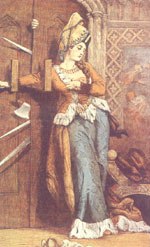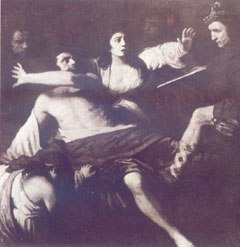|
1406-1437
Robert III's 11 (12)-year old second son James had
been captured by the English on his way to France where his father had
sent him for safety to protect him from his uncle, the Duke of Albany. He
was a prisoner of the English for the next 18 years but was well educated
by the English at the English court. At his father' s death in 1406, he
was recognized by the Scottish parliament and was finally released for a
ransom of 60,000 merks payable over six years (the Treaty of London) and
allowed to return home at the age of 21.
During his reign, he restored respect for the
monarchy. When he returned home he found that corruption prevailed, the
country was in decline and taxes were not being paid. He set out to
restore order to the Kingdom. He beheaded the Duke of Albany's son,
Murdoch, his sons and the Earl of Lennox, the first state executions in
over 100 years.
Being brought up at the English court, he tried to
reform the Scottish parliament in the style of the English but he
endeavored to weld these into existing Scottish practice. The nobles
opposed him but he passed restrictive laws curbing their power and
bringing them back into line. These laws were passed without the approval
of the King's Council and broke all the rules of law in Scotland.
His attempts at innovation were not immediately successful but his reign
is a landmark in the constitutional history of Scotland. He tried to
make parliament more efficient not because he wanted to share his
authority but because he wanted to ensure that his subjects should be
obedient and enjoy good laws, justly administered. After James had
brought the nobles into line, he turned his attention to the Church which
had also fallen into disrepute and forced the Church to exercise more
control over its clergy.

A group of nobles who were resentful of the
laws James had passed conspired together to put an end to his rule. The
conspirators hoped to win the throne for Walter, a son of Robert II by his
second marriage. The King gave a party at Blackfriars in Perth. When all
the guests had arrived, the dissenting nobles showed up even though they
had not been invited. The servants warned the king and he, fearing
for his life, went to a secret stone in the floor to escape. He went down
the steps to an underground room that he thought would lead him to safety
outside of the building. However, a week before the party the exit had
been blocked off, the story being that croquet balls were always running
through the exit and getting lost. The nobles, under the leadership
of Sir Robert Graham, searched the castle but could not find the king.
They soon discovered the stone and the king in hiding.
 The
door to his hiding place was 'barred' by
Katherine Douglas (pictured right) placing her arm through the door
staples. James begged for
mercy but was told that he had had no mercy on others and was stabbed with
a dagger (left). The murderers did not have the support of the country and Queen
Joan was determined to bring them to justice. She had them captured
and tortured mercilessly for two days. They were killed or died of
their torture. James is buried at Perth where he was murdered. The
door to his hiding place was 'barred' by
Katherine Douglas (pictured right) placing her arm through the door
staples. James begged for
mercy but was told that he had had no mercy on others and was stabbed with
a dagger (left). The murderers did not have the support of the country and Queen
Joan was determined to bring them to justice. She had them captured
and tortured mercilessly for two days. They were killed or died of
their torture. James is buried at Perth where he was murdered.
|
|


